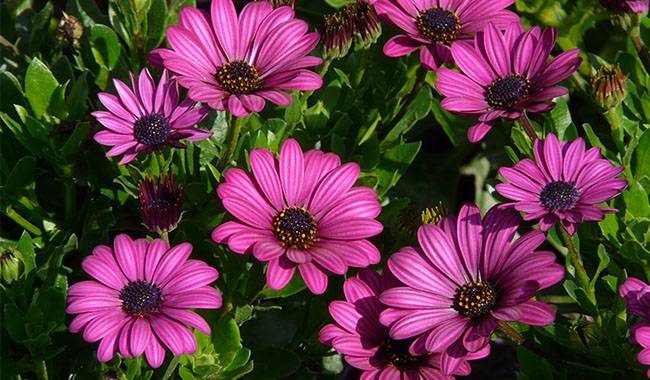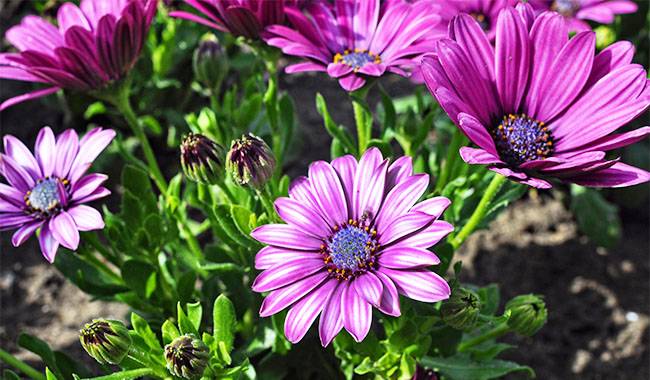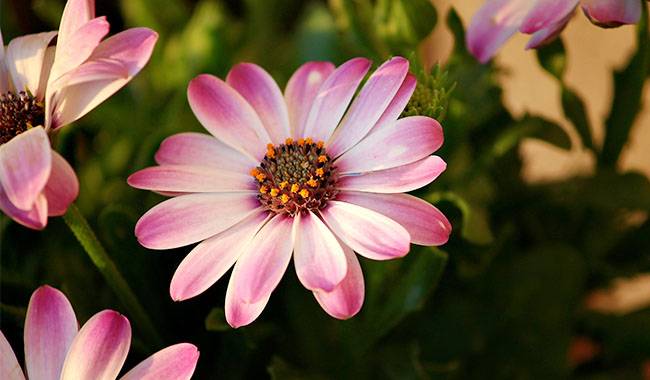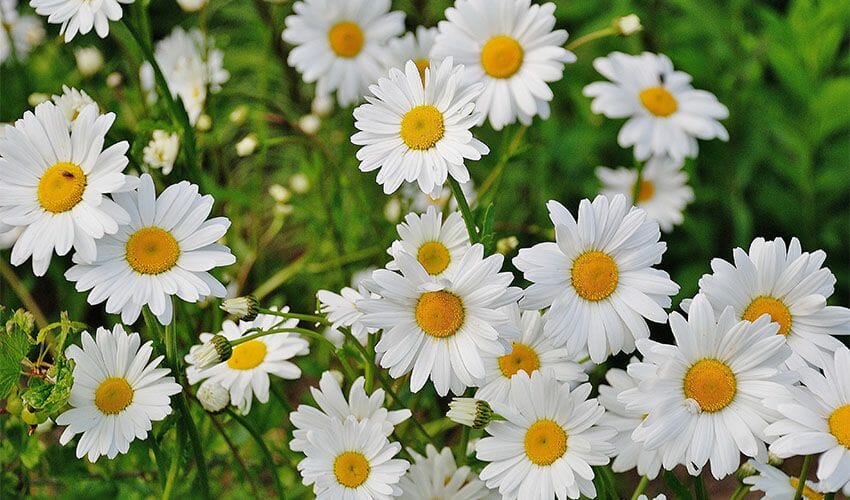
How to grow osteospermum (Blue Eyed Daisies)? This article provides answers to questions about growing osteospermum (Blue Eyed Daisies) and growing, care, and other related issues.
Blue Eyed Daisies (Latin: Osteospermum) is a genus of annual and perennial herbaceous plants, shrubs, and Hemi-shrubs in the Asteraceae family, growing mainly on the African continent. The common name is derived from the Greek word for “bone” and the Latin word for “seed”.
Osteospermum is also called “cape daisy”, “cape daisy”, “gerbera daisy”, “blue-eyed daisy”, and “South African daisy”. Why “Osteospermum”? Because the inflorescences of plants in this genus are very similar to the flowers represented by the genus Nivyanicus. several species of the genus Osteospermum are cultivated as ornamental plants.
PLANTING AND CARE OF OSTEOSPERMUM
Flowering time: midsummer to November.
Sowing: sowing seedlings – end of March or early April, open field seedlings – end of May.
Lighting: bright light or penumbra.
Soil: Loose, light, well-drained, and fertile, but not too much organic matter.
Watering: moderate, only in the dry season.
Fertilization: twice a month, with a compound mineral fertilizer at half the amount specified by the manufacturer.
Propagation: Seeds.
Insect pests: aphids.
Diseases: Rot.
BOTANICAL DESCRIPTION
Osteospermum plants reach a height of 1 m and are evergreen. The stems are erect, although there are some species with pendulous shoots.
The leaves of Osteospermum have irregularly serrated margins and flowers in boutonnieres, 1.6-4inch (4-10 cm) in diameter, consisting of white, purple, violet, pink, orange, or yellow rugose flowers, and blue central tubular flowers.
Unlike other representatives of the Tonicaceae family that bear tubular flowers from seed, in Osteospermum the median flowers are sterile and the seeds form ligulate flowers that marginalize the sterile middle of the inflorescence with them.
Plant Osteospermum in beds, patios, pots, and planters. Osteospermum blooms until November and is easily tolerant of high temperatures, short droughts, and a few degrees of frost. In our climate, perennial Osteospermum is mainly cultivated as an annual.
GROWING OSTEOSPERMUM FROM SEED
When and how to sow
Sow Osteospermum seeds for seedlings in late March or early April in peat patches or in boxes filled with loose peat sandy soil. If you want to speed up the seed germination process, do not soak the seeds (Osteospermum does not like it), just keep them warm on a wet towel for a few hours before sowing.
Push the seeds 5 mm deep into the moist substrate, using a toothpick to push deep into the substrate. Keep the seeds at a temperature of 68-71°F (20-22°C).
Shoots can appear as early as one week, and once this occurs, move the seeds as close to the light as possible. After 2-3 true leaves have emerged and grown, set the box seedlings into separate containers and deepen the stems.
Slightly prune the tops of transplanted seedlings of high-growing varieties for more luxuriant flowering in the future and slow down the elongation of the seedlings. in early May, start the hardening procedure by opening windows or taking the seedlings to the balcony for 10-15 minutes and gradually increase the time.
PLANTING OSTEOSPERMUM IN THE OPEN GROUND
Osteospermum seedlings can be planted in the open ground at the end of May. osteospermum prefers a sunny place, but it feels good in semi-shade too. Dig a row of deep holes at a distance of 8-10inch (20-25cm) and put the roots of the seedlings into the holes together with the soil blocks. After transplanting the seedlings, fill each hole with nutrient soil, which consists of equal amounts of sand, humus, leaf soil, and turf soil. The ground is compacted and the plants are given plenty of water. osteospermum flowers from seed in June.
CARE OF OSTEOSPERMUM IN THE GARDEN
Planting conditions
Planting and caring for Osteospermum is not difficult and pleasant. The plant needs moderate watering, plenty of fertilizer during flowering, and timely removal of faded inflorescences. If the nights in May are cold, the seedlings need protection from frost.
In seasons with normal precipitation, Osteospermum in the open ground can be grown without irrigation, but if there is a prolonged drought, the ornamental value of the flowers will be affected and the flowers will become shallow due to lack of water.
To make Osteospermum bloom long and lush, apply a mineral compound fertilizer every two weeks at half the amount recommended by the manufacturer. Sometimes the plant stops forming buds due to severe heat, but as soon as the temperature drops, Osteospermum will resume intensive flowering.
Pests and diseases
Growing and caring for Osteospermum requires protective measures against pests and diseases, which can occur even though Gerbera is extremely resistant to infection and pests.
For example, growing in the shade and watering heavily and frequently can lead to a weakening of the plant’s immunity and cause Osteospermum to be attacked by fungal diseases: the plant’s roots begin to rot, and the shrub wilts.
So let Osteospermum grow in full sun and let the soil dry out between waterings. Treat diseased bushes with a fungicide solution.
Weakened Osteospermum is easy prey for aphids, which settle on the stems and leaves and feed on their sap, causing the leaves to turn yellow and fall off and the bush to wilt. Aphids are killed with acaricides.
OSTEOSPERMUM AFTER FLOWERING
The annual Osteospermum dies with the onset of winter, but there is a way to extend its life and make it a perennial Osteospermum. to do this, dig up the plant in autumn, transplant it into a pot and bring it into a shady room. the Osteospermum will delight you with a long flowering period.
SPECIES AND VARIETIES
In nature, there are about 45 species of Osteospermum.






